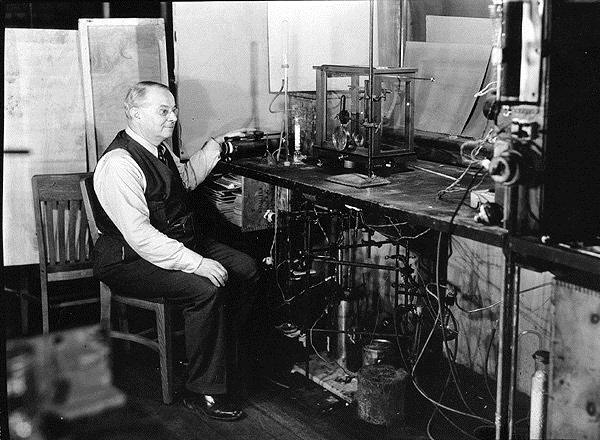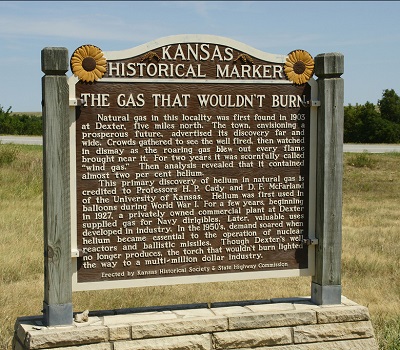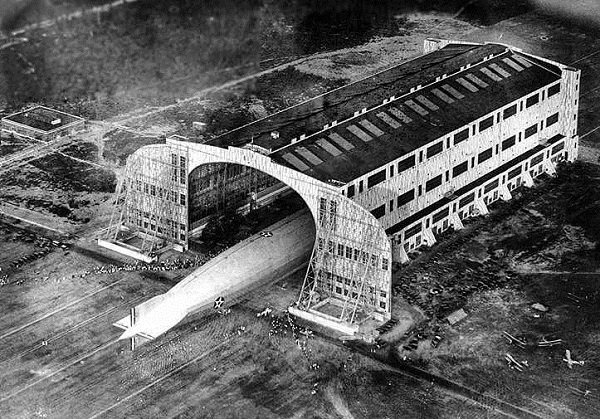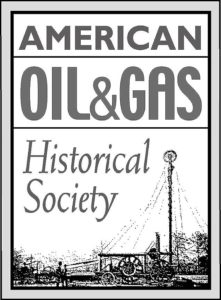The gas that would not burn — and the professor who in 1905 extracted helium from a natural gas well.
Drilling for natural gas in May 1903, an exploratory well drilled by Gas, Oil and Developing Company found natural gas beneath William Greenwell’s farm near Dexter, Kansas. The discovery came as the company drilled into a geologic formation that produced “a howling gasser” that would not burn.
The Gas, Oil and Developing Company well daily produced about nine million cubic feet of what turned out to be helium-rich natural gas from a depth of just 560 feet. Discovery of a natural gas field promised economic growth for the small farming town of Dexter.

Kansas University professor Hamilton P. Cady, above, discovered significant amounts of helium in a natural gas sample from a well drilled near Dexter, Kansas. He and D.F. McFarland made the discovery in 1905.
After the discovery — and envisioning a prosperous future — the Kansas community planned to advertise its natural gas field similar to towns in Indiana and Ohio. Abundant natural gas supplies in those states (from the Trenton Field) led to a natural gas boom, bringing pipelines and many manufacturing industries.
An 1886 natural gas field discovery well 100 miles southwest of Findlay, Ohio, had flowed at 12 million cubic feet per day. With technologies like the blow-out preventer yet to be invented, the “Great Karg Well” could not be brought under control.
After igniting, the Ohio well’s pressurized plume burned for four months. It became a popular tourist attraction. In 1906, oilfield fire-fighting technologies were tested in Kansas by a blazing, out-of-control well in Caney (see Kansas Gas Well Fire). Dexter’s residents also had read newspaper accounts of their state’s potential petroleum riches since the first Kansas oil well of 1892 at Neodesha. An excited crowd would gather expectantly at the Gas, Oil and Developing Company well.
The Gas That Wouldn’t Burn
“Darkness came, the mayor made a speech, and he called for a bale of burning hay to be tossed onto the well. To the crowd’s dismay, the gas extinguished the hay. More attempts were made without success, and eventually the crowd left, their dreams shattered,” noted John A. Taylor in his 2022 book, Helium: Its Creation, Discovery, History, Production, Properties and Uses.
The Cowley County well’s “roaring gas blew out every flame brought near it,” adds a Kansas State Historical Marker (no. 59). The flowing well produced another kind of gas with the natural gas.
As the historical marker explains, the well was unusual because it produced, “The Gas That Wouldn’t Burn.”

Although no longer producing, Cowley County residents still celebrate their 1903 Dexter “wind gas” well.
For the next two years, the Dexter well was scornfully called the “Wind Gas” well by disappointed residents. The Gas, Oil and Developing Company disappeared by the time scientific analysis revealed the natural gas contained almost two percent helium.
Discovering Helium
Scientists determined that Dexter’s gas wouldn’t burn because it contained mostly nitrogen with some methane, but for the first time in history, they found helium as a constituent of natural gas.

A Dexter, Kansas, marker notes a nearby gas well led to a scientific discovery that “lighted the way to a multi-million dollar industry.”
“This primary discovery of helium in natural gas is credited to Professors H. P. Cady and D. F. McFarland of the University of Kansas” explains the historical marker 12 miles west of Cedar Vale at the K-15 junction. The Dexter discovery would help launch the first U.S. Navy airships.
According to the American Chemical Society, any practical use for helium was years away. “In the decade that followed, helium remained a curiosity and the entire U. S. supply rested in three glass tubes on a shelf.”
The historical marker outside Dexter continues: Helium was first used in balloons during World War I. For a few years, beginning in 1927, a privately owned commercial plant at Dexter supplied gas for Navy dirigibles. Later valuable uses developed in industry.
In the 1950’s, demand soared when helium became essential to the operation of nuclear reactors and ballistic missiles. Though Dexter’s well no longer produces, the torch that wouldn’t burn lighted the way to a multi-million dollar industry.

The Shenandoah, built in 1923 and shown emerging from its Lakehurst, N. J. hangar, was the U.S. Navy’s first helium-filled airship. The Navy’s second (1924) was the Los Angeles, but helium was so scarce that only one of these airships could be operated at a time.
Although the United States would become the world’s largest producer of helium, the Gas, Oil and Developing Company disappeared into thin air. Old stock certificates from the company have been popular to collectors — but not for producing wealth for the company’s investors.
Modern industrial extraction plants draw helium from natural gas with annual global production of about 175 million cubic meters.
Although the Dexter well produced “The Gas That Wouldn’t Burn,” it led to scientific advances that lighted the way for a multi-million dollar industry, according to the American Chemical Society, which designated the discovery of Kansas helium in natural gas a national historic chemical landmark in 2000.
It all began where helium was discovered in a natural gas field — Dexter, the small town still proud of its rare atmosphere. Learn more Kansas petroleum history in Kansas Well reveals Mid-Continent.
_______________________
Recommended Reading: Helium: Its Creation, Discovery, History, Production, Properties and Uses (2022); Helium: The Disappearing Element (2015). Your Amazon purchase benefits the American Oil & Gas Historical Society. As an Amazon Associate, AOGHS earns a commission from qualifying purchases.
_______________________
The American Oil & Gas Historical Society (AOGHS) preserves U.S. petroleum history. Please become an AOGHS annual supporter and help maintain this energy education website and expand historical research. For more information, contact bawells@aoghs.org. © 2024 Bruce A. Wells. All rights reserved.
Citation Information – Article Title: “Kansas ‘Wind Gas’ Well.” Authors: B.A. Wells and K.L. Wells. Website Name: American Oil & Gas Historical Society. URL: https://aoghs.org/stocks/gas-oil-and-developing-company-the. Last Updated: November 30, 2024. Original Published Date: February 14, 2013.



